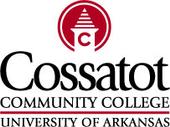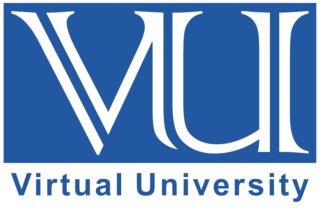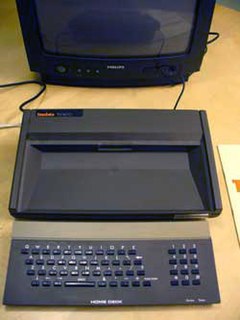Related Research Articles

Distance education, also known as distance learning, is the education of students who may not always be physically present at a school, or where the learner and the teacher are separated in both time and distance. Traditionally, this usually involved correspondence courses wherein the student corresponded with the school via mail. Today, it usually involves online education and the learning is usually mediated by some form of technology. A distance learning program can be completely distance learning, or a combination of distance learning and traditional classroom instruction. Other modalities include distance learning with complementary virtual environment or teaching in virtual environment (e-learning).

The Open University (OU) is a British public research university and the largest university in the United Kingdom by number of students. The majority of the OU's undergraduate students are based in the United Kingdom and principally study off-campus; many of its courses can also be studied anywhere in the world. There are also a number of full-time postgraduate research students based on the 48-hectare university campus in Milton Keynes, where they use the OU facilities for research, as well as more than 1,000 members of academic and research staff and over 2,500 administrative, operational and support staff.

"The Open University of Sri Lanka" is a national university in Sri Lanka. It is unique within the Sri Lankan national university system for being the only university to offer programs of study leading to certificate, diploma, degrees and postgraduate degrees up to PhD level through the Open and Distance Mode of Learning (ODL). The degrees awarded by the university are treated as equivalent to degrees awarded by any other Sri Lankan University under the preview of the University Grants Commission.
Asynchronous learning is a general term used to describe forms of education, instruction, and learning that do not occur in the same place or at the same time. It uses resources that facilitate information sharing outside the constraints of time and place among a network of people. In many instances, well-constructed asynchronous learning is based on constructivist theory, a student-centered approach that emphasizes the importance of peer-to-peer interactions. This approach combines self-study with asynchronous interactions to promote learning, and it can be used to facilitate learning in traditional on-campus education, distance education, and continuing education. This combined network of learners and the electronic network in which they communicate are referred to as an asynchronous learning network.

An online school teaches students entirely or primarily online or through the Internet. It has been defined as "education that uses one or more technologies to deliver instruction to students who are separated from the instructor and to support regular and substantive interaction between the students. Online education exists all around the world and is used for all levels of education. This type of learning enables the individuals to earn transferable credits, take recognized examinations, and advance to the next level of education over the Internet.
Educational technology is the combined use of computer hardware, software, and educational theory and practice to facilitate learning. When referred to with its abbreviation, edtech, it is often referring to the industry of companies that create educational technology.
A virtual campus or e campus, refers to the online offerings of a college or university where college work is completed either partially or wholly online, often with the assistance of the teacher, professor, or teaching assistant. Many colleges and universities now offer such courses either partially or wholly online. There are an estimated 4,500 such institutions with total enrollments approaching perhaps 2 million.

Cossatot Community College of the University of Arkansas (CCCUA) is a public community college serving southwest Arkansas. Its main campus is located in the foothills of the Ouachita Mountains in De Queen, Arkansas.

The University of the Philippines Open University(UPOU) is a public research and open university and distance education institution headquartered in the town of Los Baños, Laguna, with satellite offices in Quezon City, Metro Manila. It is the fifth constituent university of the University of the Philippines System.
An online degree is an academic degree that can be earned primarily or entirely through the use of an Internet-connected computer, rather than attending college in a traditional campus setting. Improvements in technology, the increasing use of the Internet worldwide, and the need for people to have flexible school schedules while they are working have led to a proliferation of online colleges that award associate, bachelor's, master's, and doctoral degrees.
A correspondence law school is a school that offers legal education by distance education, either by correspondence or online by use of the internet, or a combination thereof.

The Virtual University of Pakistan (VU) is a public university located in the urban area Head Office M.A Jinnah Campus, Defence Road, Off Raiwind Road Lahore, Punjab, Pakistan. University Encourage on modern Information and Communication Technologies.
The Virtual Global University (VGU) is a virtual university offering online distance education or virtual education on the Internet.
CU Online represents the University of Colorado’s fully-online bachelor’s, master’s, doctorate, and certificate programs. Originally launched by the University of Colorado Denver in 1996, it is one of the first fully-accredited online higher education platforms. Today, CU Online offers degree programs from all four University of Colorado campuses – CU Boulder, CU Colorado Springs, CU Denver, and CU Anschutz Medical Campus.
In the history of virtual learning environments, the 1990s was a time of growth, primarily due to the advent of the affordable computer and of the Internet.

A virtual learning environment (VLE) is a system that creates an environment designed to facilitate teachers' management of educational courses for their students, especially a system using computer hardware and software, which involves distance learning. In North America, a virtual learning environment is often referred to as a "learning management system" (LMS).

The Valencian International University (VIU) is a private university in Spain with an international remit. It was founded by the regional government of Valencia in 2008. 70% of it was later acquired by the Planeta publishing house. The university is officially recognized by the Spanish Ministry of Education. It is headquartered in Valencia, Spain.
Oregon State University Ecampus is the online education unit of Oregon State University. OSU Ecampus develops and delivers courses, degree programs and certificate programs online and at a distance to students worldwide. Ecampus courses and programs are delivered online or in a hybrid format that combines virtual learning with face-to-face instruction.

Online learning involves courses offered by primary institutions that are 100% virtual. Online learning, or virtual classes offered over the internet, is contrasted with traditional courses taken in a brick-and-mortar school building. It is a development in distance education that expanded in the 1990s with the spread of the commercial Internet and the World Wide Web. The learner experience is typically asynchronous but may also incorporate synchronous elements. The vast majority of institutions utilize a learning management system for the administration of online courses. As theories of distance education evolve, digital technologies to support learning and pedagogy continue to transform as well.
E-Learning, or educational technology, in Pakistan has developed mostly in the 21st century. Online universities and e-learning platforms in the country have also opened in recent years. The introduction of 3G/4G technology has contributed to the growth in m-learning, allowing the incorporation of e-learning in classrooms as well as in informal education. Education in Pakistan is under the administration of Federal and provincial governments, allowing multiple e-learning opportunities for individuals in Pakistan.
References
- ↑ "USF College of Education Home Page". Coedu.usf.edu. Retrieved 2010-06-24.
- ↑ "Open to Change: An Interview with Leaders of the Open University". Educause. 14 March 2008. Retrieved 12 April 2014.
- 1 2 "Distance Learning Courses and Adult Education - The Open University". Open.ac.uk. Retrieved 2010-06-24.
- ↑ Tiffin and Rajasingham (2003)The Global Virtual University London and New York, Routledge
- ↑ Sanford, Michael Ellis; Peters, Sophia. "On Teaching Modalities Of Virtual Universities & Online Course Providers". Class Consultants. Retrieved 25 November 2014.
- ↑ "News". Online UC. Retrieved 2010-06-24.